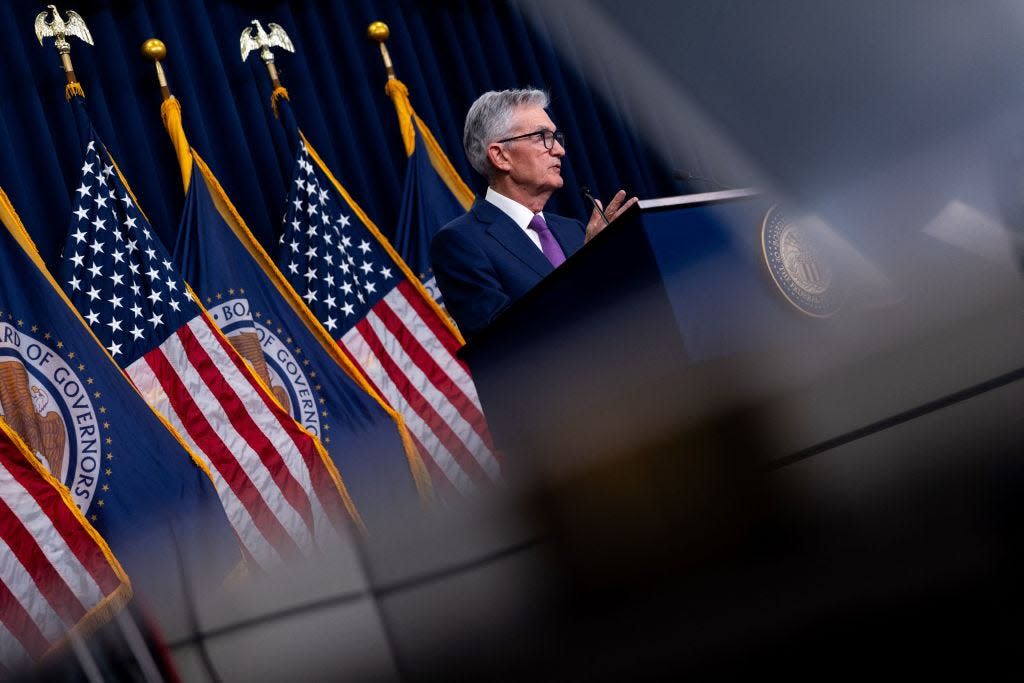The Fed still probably isn't ready to give Americans the interest rate cuts they're hoping for

The Federal Reserve is expected to continue holding interest rates steady on Wednesday.
Fed Chair Jerome Powell previously said it'll take more data before he feels confident cutting rates.
Still, the door is open for rate cuts later in the year.
The nation's central bank is gearing up to make its second interest rate decision of the year, and it probably won't be the relief many Americans want to see.
On Wednesday, the Federal Open Market Committee is set to announce whether it will continue its pause on interest-rate hikes — and based on predictions, that's likely to be the case. According to the CME FedWatch tool, which estimates the probability of the Federal Reserve's next move based on market predictions, there's a 99% chance rates will remain steady as of Monday morning.
The Fed's December Summary of Economic Projections penciled in three interest rate cuts for 2024, but as Fed Chair Jerome Powell has emphasized since then, those forecasts could change based on the economic data that comes in. For example, the year-over-year percent change in the consumer price index — which measures inflation — was 3.2% in February, which is close to the 3.1% in January and remains above the Fed's 2% inflation target.
"The CPI has come in hotter than expected, and that's disappointing," Mark Hamrick, a senior economic analyst for Bankrate, told Business Insider. "It's disappointing because Americans want to be relieved of the burden of ongoing inflation."
"Not only do we still have persistently high prices, but we also have high interest rates and we have an economy that's moderating," Hamrick said. "Those things should continue to take some of the starch out of prices."
Powell also said earlier in March that there's no rush for the Fed to cut rates, telling the House Financial Services Committee that cutting rates too soon or too much could "ultimately require even tighter policy to get inflation back to 2%."
"We want to see a little bit more data so that we can become confident," Powell said. "We're not looking for better inflation readings than we've had. We're just looking for more of them."
Still, this doesn't mean rate cuts won't come later this year. Nick Bunker, economic research director for North America at the Indeed Hiring Lab, told BI after February's jobs report was published earlier this month that the pull back in average hourly earnings growth is "a positive trend for the Fed" because the Fed can feel "the labor market's holding up, but maybe wage growth is moderating enough to make them feel" that "inflationary pressures" are waning.
Average hourly earnings increased by 4.3% to $34.57 in February from the average a year ago. That's down from the 4.7% increase from February 2022 to February 2023.
While experts expected 2024 to be a cooler labor market, US job growth so far has been pretty robust. Based on preliminary or revised numbers, there have been over 200,000 jobs added each month from December to February. But the unemployment rate rose from 3.7% in January to 3.9% in February while the labor force participation rate didn't move from its rate of 62.5%.
Julia Pollak, chief economist at ZipRecruiter, told BI after the jobs report was published that the Fed "could be quite concerned about this increase in the unemployment rate and about slacker labor market conditions." She added this "should translate into weaker wage growth going forward and could be disinflationary."
"On the other hand, the continued strength in that payroll number could, I think, give them a false sense of confidence that the labor market is immune and can withstand restrictive monetary policy for longer," Pollak added.
Still, while Americans may not see an interest rate cut this month, they could see one later on this year.
"I believe that it's still reasonable to believe that rates will come down this year," Hamrick said after the most recent CPI report was published. "The timing has continued to get pushed out farther and farther. And it's going to be obviously dependent on the data. And when the data is not sort of aligning with a certain set of expectations, then other expectations may have to be adjusted. But I still think interest rate cuts of one form or the other are likely this year."
A group of Democratic lawmakers are also urging Powell to develop a timeline in which Americans can expect to see rate cuts. On Monday, 22 of them — led by the Congressional Progressive Caucus — sent a letter to Powell asking him to "seriously consider the harmful economic consequences of maintaining excessively high interest rates for an unnecessarily long period of time."
"We believe it is critical for the FOMC to present the public with a clear and rapid timetable for reducing interest rates, ideally beginning at the May FOMC meeting in order to ensure a strong labor market and full employment for working Americans," they wrote. "This would allow for the continued reduction in decades of historically high wage inequality, and promote a strong climate for investment."
Read the original article on Business Insider
